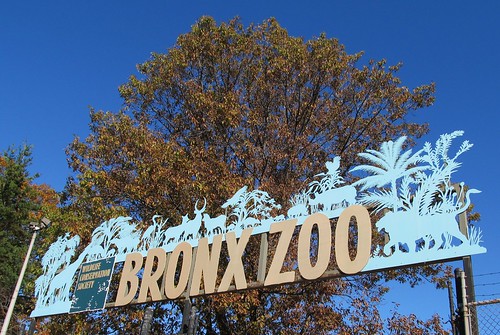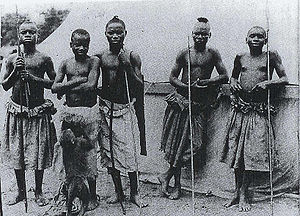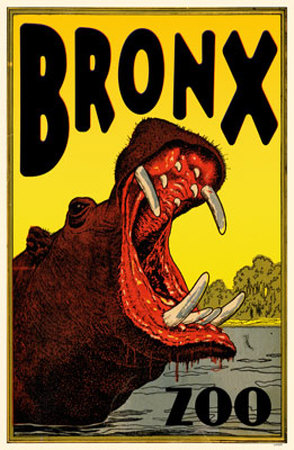From the Daily Mail, "Caged in the human zoo: The shocking story of the young pygmy warrior put on show in a monkey house - and how he fuelled Hitler's twisted beliefs," by Beth Hale, 31 October 2009
His ebony skin stood out in sharp contrast to the white crowd pressing to get a better view.
The young African boy bared his teeth at the men and women staring at him through the bars. They were sharpened into dagger-like points, making him appear all the more barbaric to the ignorant hordes.
Above the cage hung a sign proclaiming: 'The Missing Link.' A baby chimp sat disconsolately at the bottom of the enclosure, a single companion to the boy.
The year was 1906. This was a pygmy, brought to America as a novelty to be put on display in the monkey house.
The New York Times reported: 'There were 40,000 visitors to the park on Sunday. Nearly every man, woman and child of this crowd made for the monkey house to see the star attraction in the park - the wild man from Africa.
'They chased him about the grounds all day, howling, jeering, and yelling. Some of them poked him in the ribs, others tripped him up, all laughed at him.'
This was Ota Benga, a pygmy, brought from the Congo and put on display in a zoo as an example of what scientists at the time proclaimed to be an evolutionary inferior race.
His story would divide a nation, and is now told for the first time in a new documentary, The Human Zoo.
The programme lifts the lid on a dark period in history, where 'natives' were paraded as exhibits, fueling the spread of white supremacism and even contributing to the rise of Nazism.
Tragically, Benga became the victim of one of the most awful acts of exploitation ever seen and died a shadow of the proud young tribesman who arrived in America.
So just who was he, and how did this grotesque experiment help shape the 20th century view of race?
A hundred years ago, before television and mass tourism, a handful of enterprising adventurers, anthropologists and businessman decided to bring the far-flung glories of the world to life in one place.
Huge fairs were held in Paris, London and America, exhibiting everything from Italian gondolas to African elephants.
Having promised the world, there was pressure to deliver: people were the next quarry.
In 1904, the showman anthropologist William McGee conceived the idea of a human zoo, to be held in St Louis in the U.S. state of Missouri.
It was designed to be one of the largest scientific experiments ever undertaken and would be spectacular public entertainment.
McGee wanted the tallest people in the world, veritable giants from Patagonia, at the tip of South America. He wanted the Ainu, who lived on an island north of Japan and were supposedly the hairiest humans. He placed an order for 300 Filipinos - there is no record of why he wanted so many.
His grandson, Phillips Verner Bradford, says: 'If you told him that a place was dangerous, he'd say: "I want to go there!" He was that sort of guy.'
Verner took a boat from New York to London, down the European coast and around Africa to the Congo River.
Bradford says: 'He made his way up the Congo River with steamers as far as they would go. Once he arrived at the great waterfalls, he had to hire a crew of natives.'
They encountered crocodiles and hippopotamuses, and deadly whirlpools that could sink a boat.
Eventually, Verner made it into the jungle. He blithely walked into a village of cannibals, and found that they had captured a rival tribe who were being held in cages, ready to be eaten.
To his delight, the prisoners were pygmies, or Mbuti - just what he was looking for. He began negotiating. Talking to the pygmies in their native Chiluba, he established that they would rather be taken to America than eaten. He bought six pygmies from their captors for a roll of brass wire and some salt.
One pygmy stood out. He was Ota. Photos of him taken in the Congo show a playful, chubby young man, a broad smile revealing his sharpened teeth, which were filed in his youth.
He looks healthy, spirited and full of life, standing around 4ft 8in tall.
He had never seen a white man before. Verner realised that he had a hugely marketable proposition on his hands, and made the return trip across the Atlantic with his human treasure.
The six pygmies were sent to St Louis by rail. There, they became McGee's most important exhibits, the centerpiece of the St Louis World Fair, feted by society and academics alike.
Adverts proclaimed: 'They live in forests, they are extremely shy. They eat the flesh of wild animals killed with poisoned arrows. They are cruel, finding delight in torturing animals.
'They have long heads, long narrow faces and little red eyes, set close together like those of ferrets. Their bodies are exceptionally hairy.
'A pygmy has been known to eat 60 bananas at one meal, in addition to other food, and then ask for more.
'They seem to be controlled by an impulse that makes them delight in wickedness. If caught young, they are said to make excellent servants.'
He wanted what he considered the most primitive American Indian tribe, the Cocopah in Mexico. He asked for Eskimos.
But most of all, he wanted the smallest people in the world. He needed pygmies. He had heard that they were very short and very black, and he had to have one.
Explorer Samuel Phillips Verner was dispatched by McGee to the Belgian Congo with a shopping list.
It read: 'One pygmy patriarch or chief. One adult woman, preferably his wife. One adult man, preferably his son. One adult woman, the wife of the last or daughter of the first. One female youth unmarried. Two infants. A priestess and a priest, or medicine doctors, preferably old. All of the above to be pygmies.'
Duly detailed, Verner set off for deepest Africa. He knew that this operation could be the making of him, putting him in the same league as Henry Stanley and Dr David Livingstone.
As the sales pitch shows, the human zoo played into the hands of white supremacists, teaching the public that there was a hierarchy of races, with the white man at the top and all others beneath.
McGee himself, in his book The Trend Of Human Progress, published in 1899, wrote: 'Those who know the races realise that the average white man is stronger of limb, fleeter of foot, clearer of eye, than the average yellow or red or black.'
Bastardising Darwin's theory of evolution, McGee saw each race as a stage in human evolution - with pygmies the least evolved of the species. With his rudimentary Victorian understanding of science, he believed they were the living missing link between apes and humans.
The human zoo was a fantastic success - and widely copied. Dr Sadiah Qureshi, a historian at the University of Cambridge, says: 'Millions of people went to see these shows at their peak. Originally you would get a show in a local theatre. By the late 19th century you would see hundreds, if not a couple of thousand people living on site, eating and on constant display.'
Indeed, some years later, in 1924, King George V and Queen Mary inspected the live exhibits at the British Empire Exhibition, at Wembley. Some Europeans' curiosity knew no bounds, however.
Qureshi says: 'The 1899 exhibition Savage South Africa held at Earl's Court in London caused quite a stir. At one point women were banned from going inside because they had supposedly been touching the natives.' For almost a year, Ota and the other pygmies lived in America as human exhibits. They were made to build native houses, perform traditional dance ceremonies, live partially naked and cook authentic food.
Ota was described in the press as 'a dwarfy, black specimen of sad-eyed humanity'. With his filed tribal teeth, he was the most celebrated pygmy and dubbed 'Lord of the savage world'. He posed for photographs for 25 cents.
In 1905, after they had been viewed by a total of 20 million people, Verner took the pygmies home to the Congo.
Ota had planned to rejoin his tribe - but discovered that they had been entirely wiped out by Belgian soldiers. He married a girl from the nearby Batwa tribe, and appeared to settle back into life in Africa.
Then his wife was bitten by a poisonous snake and died. The Batwa rejected him, believing he was cursed and responsible for the young woman's death. Ota was cast adrift, a stranger in his own land.
He begged his friend Verner to take him back to America. Verner was reluctant, but eventually acquiesced, taking him to New York.
The pair shared the 3,000-mile sea voyage with crates of live animals, parrots, monkeys, snakes and other exotic booty, which Verner planned to sell in America. On the ship, Ota discovered cigarettes and drink.
Arriving in New York, Verner - who had business to do - bade him farewell, arranging accommodation in a spare room - this time he was not on show - at the American Museum of Natural History. There, he thought Ota would be safe.
Soon, however, he came to the attention of William Hornaday, a conservationist and director of the Bronx Zoo.
Collaborating with one of America's most notorious racists, Madison Grant, he conceived a plan.
Grant wanted to promote 'scientific racism', talking in terms of 'purity of type', and the survival of the white master race.
In 1930, after his work The Passing Of The Great Race was translated into German, Grant received a letter from an aspiring politician, saying 'your book is my bible'.
The man was Adolf Hitler. He would indeed use 'scientific racism' as the foundation for the Third Reich, giving academic grounding to the Holocaust.
Together, Hornaday and Grant offered to take charge of Ota Benga, who initially believed he would be looking after the Bronx Zoo's elephants.
In fact, he was going to be put on public display as a living example of 'racial inferiority'. Immediately, the exhibition prompted criticism. The New York Times reported on September 9, 1906: 'The exhibition was that of a human being in a monkey cage. A human being. In a monkey cage.
'The human being happened to be a Bushman, one of a race that scientists do not rate high in the human scale, but to the average nonscientific person in the crowd of sightseers there was something about the display that was unpleasant.
'It is probably a good thing that Benga doesn't think very deeply. If he did it isn't likely that he was very proud of himself when he woke in the morning and found himself under the same roof with the orang-utans and monkeys, for that is where he really is.'
The exhibition was a sensation. On a single day, 40,000 people arrived to see Ota and his chimp. The show lasted only two weeks, however, due to a public outcry, and human zoos as a phenomenon died out by the Forties.
So what became of Ota Benga? After he was removed from the Bronx Zoo, there was great debate regarding his fate. African-American church ministers insisted he be released - not for his comfort, but because they wanted to convert the pygmy to Christianity.
He was eventually placed in an orphanage for black children, the Howard Colored Orphan Asylum, to be 'civilised'. He was dressed in Western clothes and taught how to eat, talk and behave like an American.
He had his pointed teeth capped and attended a Baptist seminary, where he started to study English.
He was kept out of the public eye for four years. Eventually, he moved from New York to the backwater town of Lynchburg, Virginia, where he became a local curiosity and was known as Otto Bingo.
Forevermore haunted by his time in the monkey cage, he would repeatedly slap his chest, declaring: 'I am a man. I am a man.'

He began to save money to return to the Congo, working in a tobacco factory. With the outbreak of World War I, this became impossible and Ota sunk into depression.
He never did make it home. One evening, he went into a barn behind the village general store. He chipped off the caps hiding his teeth, restoring them to their filed-down glory, lit a small ceremonial campfire, and shot himself in the head, dying ten years after being put on display at the Bronx zoo. He was 32 years old.
His story now bears testament to the ignorance of those who believed themselves superior to him.
He was buried in an unmarked grave, but he left his mark on the world, exposing as moral pygmies the lesser men who would cage a human. (source: Daily Mail)
Human Zoos - Dirty Secrets of Science










No comments:
Post a Comment